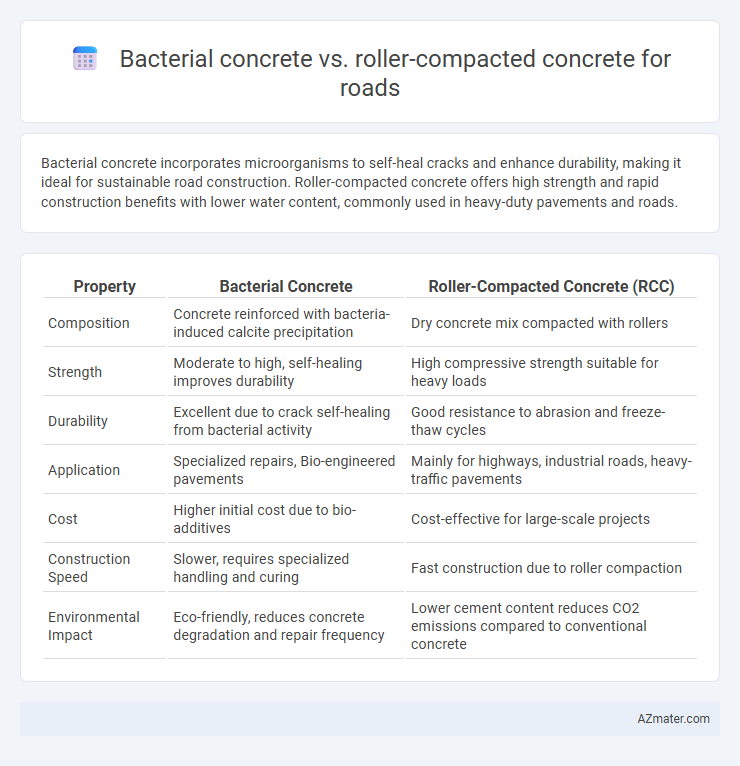Bacterial concrete incorporates microorganisms to self-heal cracks and enhance durability, making it ideal for sustainable road construction. Roller-compacted concrete offers high strength and rapid construction benefits with lower water content, commonly used in heavy-duty pavements and roads.
Table of Comparison
| Property | Bacterial Concrete | Roller-Compacted Concrete (RCC) |
|---|---|---|
| Composition | Concrete reinforced with bacteria-induced calcite precipitation | Dry concrete mix compacted with rollers |
| Strength | Moderate to high, self-healing improves durability | High compressive strength suitable for heavy loads |
| Durability | Excellent due to crack self-healing from bacterial activity | Good resistance to abrasion and freeze-thaw cycles |
| Application | Specialized repairs, Bio-engineered pavements | Mainly for highways, industrial roads, heavy-traffic pavements |
| Cost | Higher initial cost due to bio-additives | Cost-effective for large-scale projects |
| Construction Speed | Slower, requires specialized handling and curing | Fast construction due to roller compaction |
| Environmental Impact | Eco-friendly, reduces concrete degradation and repair frequency | Lower cement content reduces CO2 emissions compared to conventional concrete |
Introduction to Innovative Road Construction Materials
Bacterial concrete incorporates microbial-induced calcite precipitation, enhancing self-healing properties and durability in road structures, offering a sustainable alternative to traditional materials. Roller-compacted concrete (RCC) is a zero-slump concrete placed with asphalt paving equipment, providing high strength and rapid construction for heavy-load roadways. Both materials represent innovative advancements in road construction, emphasizing longevity, environmental benefits, and cost-efficiency.
What is Bacterial Concrete?
Bacterial concrete is a self-healing material enhanced with specific strains of bacteria that precipitate calcium carbonate to fill cracks and improve durability in road construction. Unlike roller-compacted concrete, which relies on mechanical compaction for strength and rapid setting, bacterial concrete actively repairs micro-cracks reducing maintenance needs and enhancing longevity. This bio-mediated approach increases resistance to environmental degradation, making it a sustainable alternative for long-lasting pavement infrastructure.
Overview of Roller-Compacted Concrete
Roller-compacted concrete (RCC) is a highly durable, zero-slump concrete mixture compacted with heavy rollers, primarily used in road construction for high-traffic areas due to its rapid placement and cost-effectiveness. RCC combines the benefits of concrete's strength with asphalt paving's construction speed, making it ideal for highways, industrial roads, and heavy-duty pavements. Its low water content and stiff consistency enhance load-bearing capacity and resistance to rutting compared to traditional concrete methods.
Material Composition and Preparation
Bacterial concrete incorporates microorganisms like Bacillus species that precipitate calcium carbonate, enhancing crack self-healing and durability by reducing porosity and permeability in the cement matrix. Roller-compacted concrete (RCC) consists of a dry concrete mix with reduced water content, mainly comprising cement, coarse aggregates, and minimal fine aggregates, compacted using vibratory rollers for rapid construction and high load-bearing capacity. Preparation of bacterial concrete involves integrating bacterial spores and nutrients into the mix before casting, while RCC requires precise moisture control and heavy compaction to achieve dense, interlocking aggregate structure suitable for road pavements.
Strength and Durability Comparison
Bacterial concrete enhances strength and durability by self-healing microcracks through microbial-induced calcite precipitation, which significantly reduces permeability and extends service life. Roller-compacted concrete (RCC) achieves high compressive strength and rapid construction with its zero-slump consistency, but may require additional maintenance due to potential cracking under heavy traffic. Comparative studies reveal bacterial concrete offers superior longevity and crack resistance in road infrastructure, while RCC balances strength with faster placement for large-scale paving projects.
Environmental Impact and Sustainability
Bacterial concrete enhances sustainability by using bio-mineralization to self-heal cracks, reducing maintenance needs and extending road lifespan while decreasing carbon emissions compared to traditional cement. Roller-compacted concrete (RCC) offers environmental benefits through faster construction and lower cement content, which minimizes material usage and energy consumption but lacks the self-healing properties of bacterial concrete. Both materials contribute to sustainable road construction, but bacterial concrete's bio-based approach provides superior long-term environmental advantages by reducing repair frequency and reliance on fossil fuel-derived materials.
Cost Analysis: Bacterial vs Roller-Compacted Concrete
Bacterial concrete often incurs higher initial material and preparation costs due to the incorporation of microbial agents, while roller-compacted concrete (RCC) benefits from lower material costs and faster construction times, reducing overall expenses. Lifecycle cost analysis reveals bacterial concrete may offer long-term savings by enhancing durability and self-healing properties, potentially lowering maintenance and repair costs compared to RCC. In road construction, the upfront economic advantages of RCC are frequently favored, but bacterial concrete's cost-effectiveness improves in projects where extended service life and reduced maintenance are critical.
Construction Process Differences
Bacterial concrete incorporates microbial-induced calcite precipitation, where bacteria are mixed with cement and aggregates, accelerating self-healing and reducing cracks during curing, while roller-compacted concrete (RCC) uses a drier mix that is laid down with asphalt pavers and compacted by heavy rollers for rapid construction and high density. The bacterial concrete process requires controlled conditions for bacterial viability and longer curing times compared to RCC's swift placement and compaction techniques that allow faster road opening times. Roller-compacted concrete typically enables continuous paving with minimal forms, contrasting with bacterial concrete's more traditional batching and curing approach for enhanced durability.
Maintenance and Longevity
Bacterial concrete enhances road maintenance by self-healing micro-cracks, significantly reducing repair frequency and extending road lifespan through bio-deposition of calcium carbonate. Roller-compacted concrete (RCC) offers high durability and load-bearing capacity with minimal upkeep due to its dense, compacted structure, making it cost-effective for heavy traffic roads. The longevity of bacterial concrete surpasses traditional RCC in environments prone to cracking, while RCC excels in rapid construction and long-term structural integrity.
Suitability for Various Road Applications
Bacterial concrete enhances durability and self-healing capabilities, making it ideal for roads with frequent micro-cracking due to heavy traffic or harsh weather conditions, especially in urban and coastal areas. Roller-compacted concrete (RCC) offers superior compressive strength and rapid construction, suitable for high-volume highways, airport pavements, and industrial roads requiring robust load-bearing capacity and quick installation. Choosing between bacterial concrete and RCC depends on specific road application needs, balancing factors like maintenance frequency, traffic load, and environmental exposure.

Infographic: Bacterial concrete vs Roller-compacted concrete for Road
 azmater.com
azmater.com